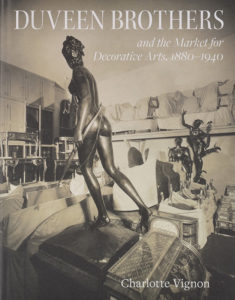New Books on Dealers and Collectors
Charlotte Vignon. Duveen Brothers and the Market for Decorative Arts, 1880–1940
(The Frick Collection, 2019) $59.95 hardcover
If you have explored the collections of French decorative arts at the Frick, Morgan, Met, or Huntington, you have undoubtedly encountered the influence of Joel, Henry, and Joseph Duveen. Vignon, Curator of Decorative Arts at The Frick Collection, crafted a nuanced and engaging volume that explores the Duveens’ impact on the collecting interests of wealthy Americans of the late 19th and early 20th centuries.
With showrooms in London, New York, and Paris, the Duveens drove the market for top-flight antiques as the most prominent dealers of their day. Patronized by the likes of John D. Rockefeller Jr., Henry Clay Frick, Arabella Huntington, and J.P. Morgan, the Duveens sold furniture, tapestries, porcelain, and other objets d’art that now hold pride of place in the foremost museum collections in the United States. By manipulating sale prices and press coverage, they placed themselves at the forefront of the field, carefully guiding these prominent customers in their search for taste and respectability while shifting Europe’s cultural patrimony across the Atlantic.
Vignon aimed to demonstrate how “this study of the countless objects, people, and places Duveen Brothers were involved with allow a broader audience to understand the profound impact the firm made on the art world in the 20th century. Particularly, their pioneering contribution to the formation of art collections
that ultimately became the foundation stones of American’s most prestigious cultural institutions.” The Duveens’ impact on the museum experience today is undeniable.
Shirley M. Mueller, MD. Inside the Head of a Collector: Neuropsychological Forces at Play
(Lucia Marquand, 2019) $28.49 hardcover
Mueller is a prominent collector and scholar of Chinese export porcelain, as well as a physician board-certified in Neurology and Psychiatry. This intersection of expertise led her to explore her own intentions while collecting art and the applicability of those factors to a broader community of collectors. Her research provided the motivation for this book, a worthy acquisition for those who have felt the thrill of the hunt and the angst of the one that got away (or the one that was not quite right).
Collecting objects gives enormous pleasure to approximately one third of the population, providing such benefits as intellectual stimulation, the excitement of the chase, and leaving a legacy. Alternatively, the same pursuit can engender pain by paying too much for an object or unknowingly buying a fake. In this three-part treatise, Mueller introduces new scientific research in neuro- and behavioral economics that delivers an objective way to enhance the positive aspects of collecting and minimize the negative. Her information is relevant not only for collectors but also for the museum staff who interact with collectors and the dealers of objects desired by collectors. The author beautifully blends art and science for the benefit of the reader, and the case studies that accompany each section add real-world context to the discussion.
A print version of this article was published in The Magazine of the Decorative Arts Trust, one of our most popular member benefits. Join today!
This summer the Decorative Arts Trust chose The Power of Objects in Eighteenth-Century British America by Jennifer Van Horn for the 2019 summer reading selection. Dr. Van Horn is an assistant professor of art history and history at the University of Delaware, where she teaches courses on 18th- and 19th-century decorative arts, material culture theory and methodology, the production of historical memory, and archival practices. She is a graduate of the University of Delaware’s Winterthur Program in Early American Culture and the University of Virginia, and previously worked at George Washington’s Mount Vernon. Her book discusses the connection between the full breadth of material culture and the development of 18th-century Anglo-American communities.
Van Horn explores the sheer quantity and variety of goods Anglo-Americans were purchasing in the 18th-century and the central importance of objects to the identity politics of their time. She analyzes material goods—from women’s dressing tables to gravestones to even a wooden prosthetic leg—to demonstrate the centrality of material culture in the construction of uniquely Anglo-American communities within the British Empire. Drawing a deeper connection between object and owner, Van Horn also builds on the traditional role of goods as a means to secure social status and power by demonstrating how these purchases also distanced elite Anglo-Americans from African Americans and Native Americans. (University of North Carolina Press, 2019)
Additional books to consider for your summer reading list:
- Face Value: The Consumer Revolution and the Colonizing of America by Cary Carson (University of Virginia Press, 2017) discusses how the rise of gentry culture in the mid-18th century set the stage for a consumer revolution. During this time, Americans expanded their desire for a variety of luxury goods, abandoning the traditional sameness of material life. About mid-century, though, a lust for fancy goods, coupled with social aspiration, began to transform American society. Carson addresses the intriguing question of how Americans developed the reputation for avid consumption.
- Independence Lost by Kathleen DuVal (Random House, 2016) offers a significant new global perspective on the Revolutionary War with the story of the conflict as seen through the eyes of the outsiders of colonial society. Duval delivers the history of the Revolutionary Era as experienced by slaves, American Indians, women, and British loyalists living on the Gulf Coast. DuVal teaches early American history and American Indian history at the University of North Carolina at Chapel Hill.
- Jefferson’s Treasure: How Albert Gallatin Saved the New Nation from Debt by Gregory May (Regnery History, 2018) describes the significant contributions of Gallatin, a Swiss immigrant who served as Treasury secretary during Thomas Jefferson’s presidency. Gallatin’s reforms to government policy set a new precedent for fiscal responsibility that lasted well into the 20th century. An internationally known tax expert with an interest in historic preservation, May’s unique background allowed him to craft a book exploring Gallatin’s lasting influence on American fiscal policy.







